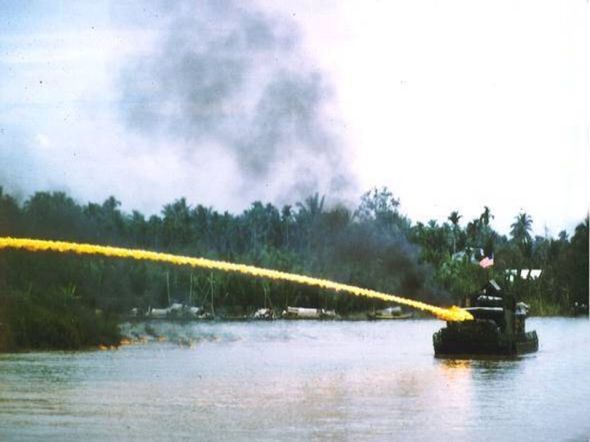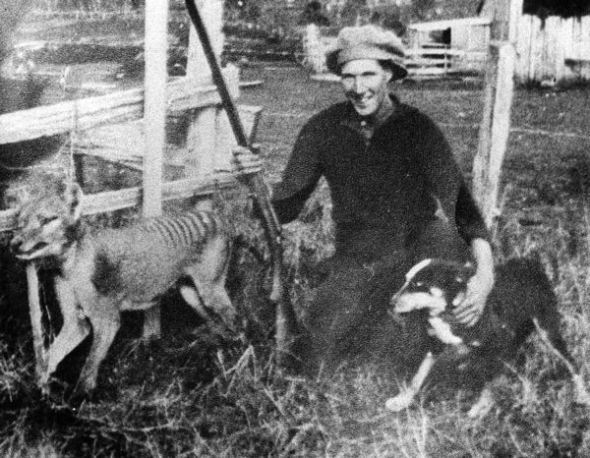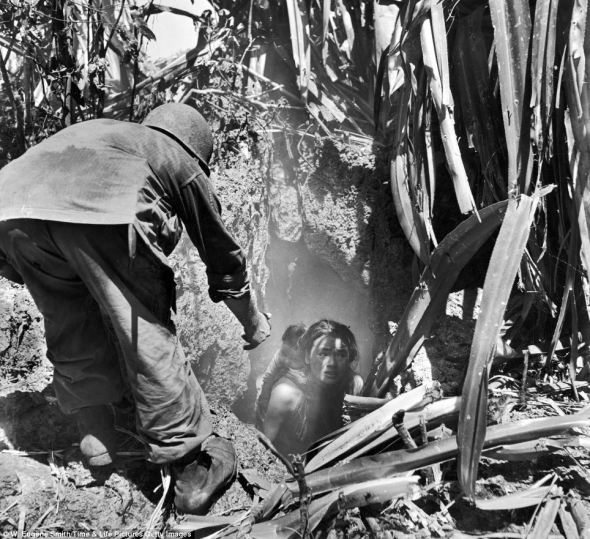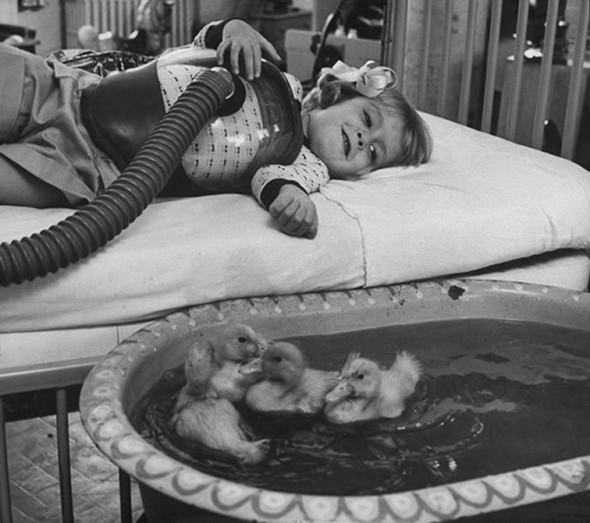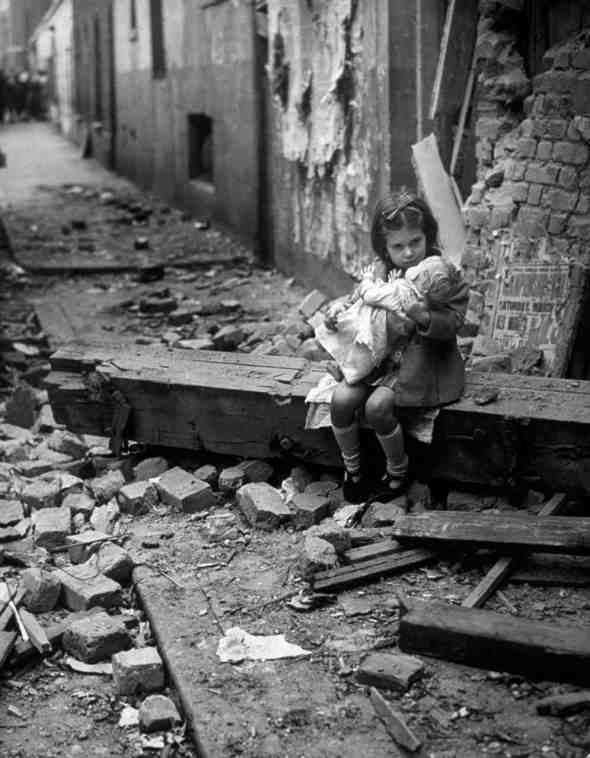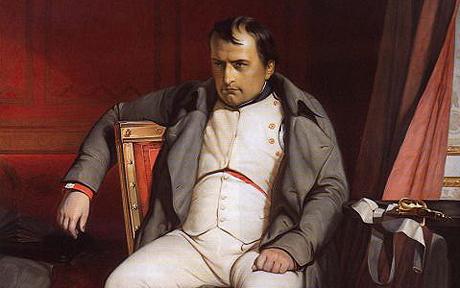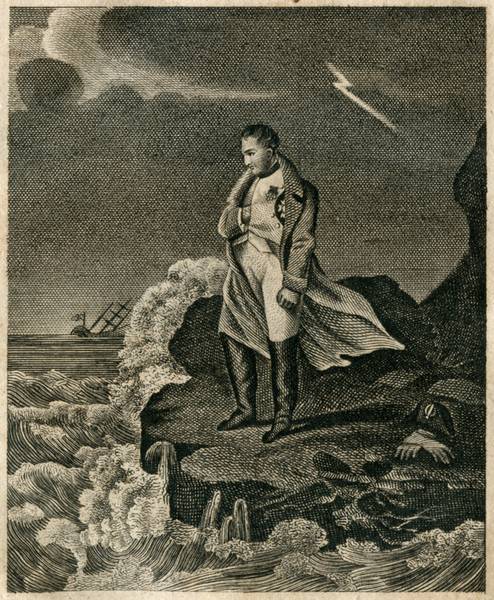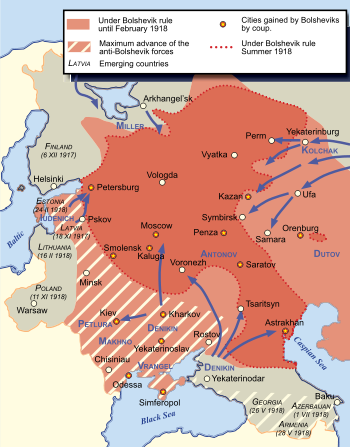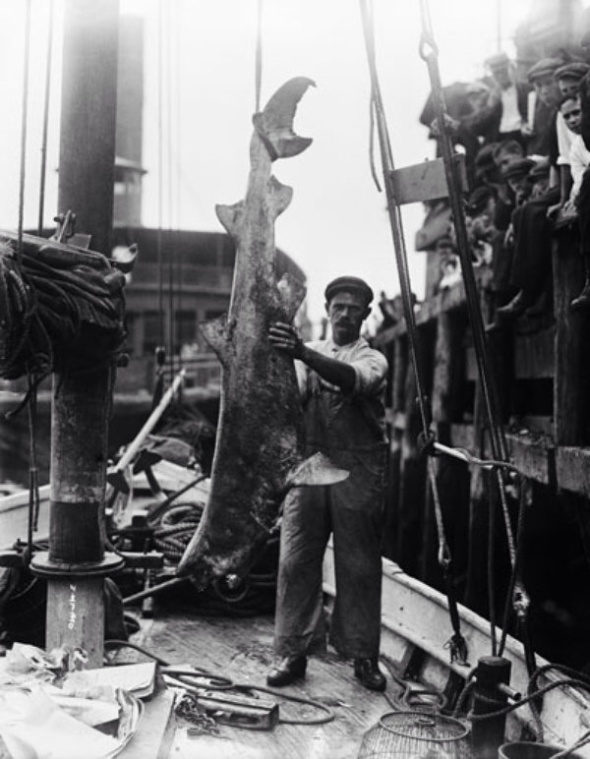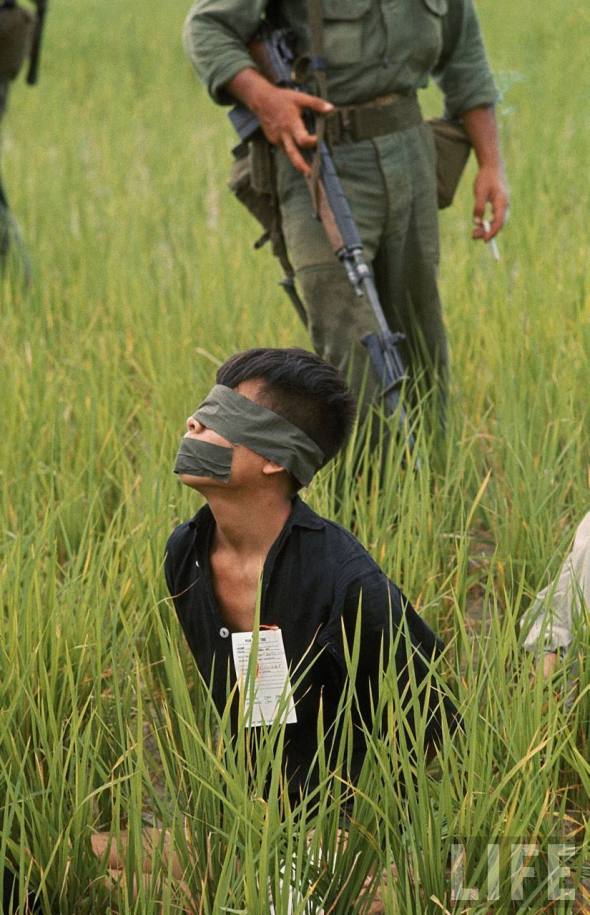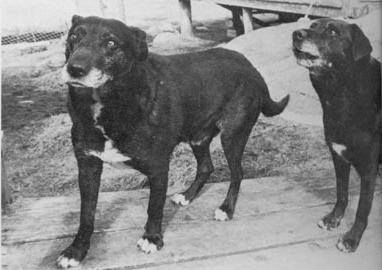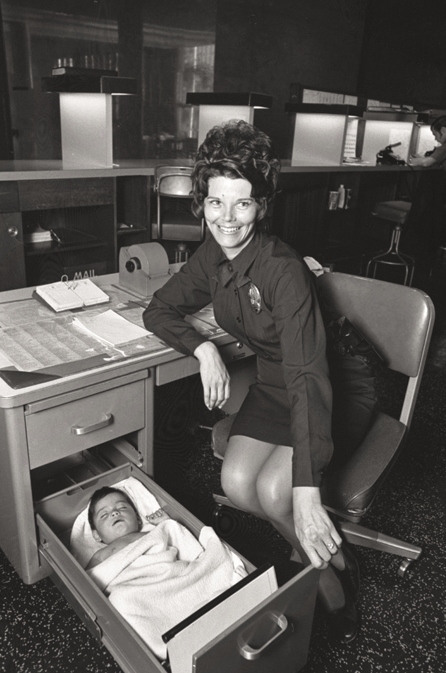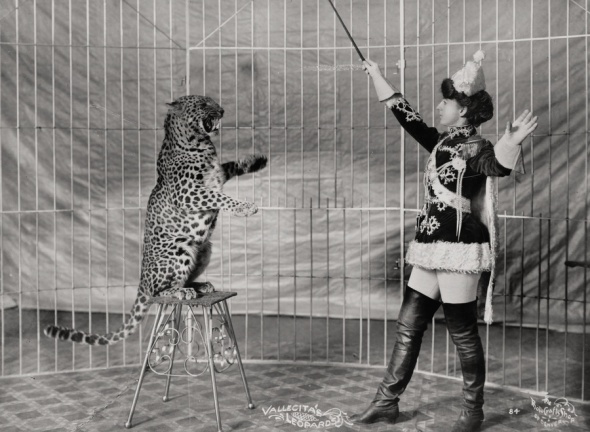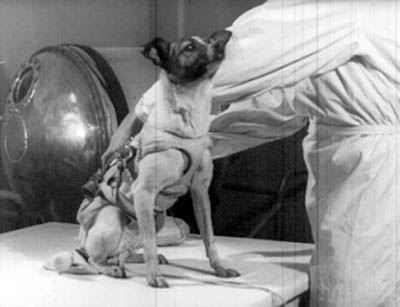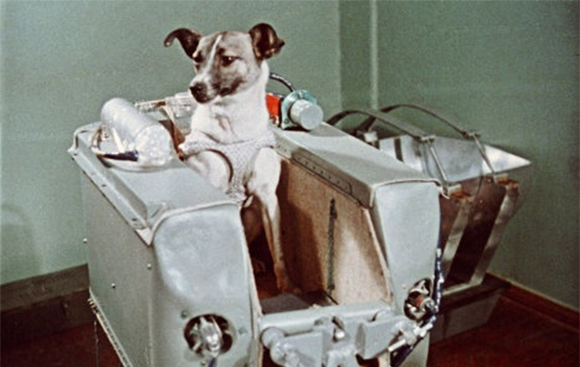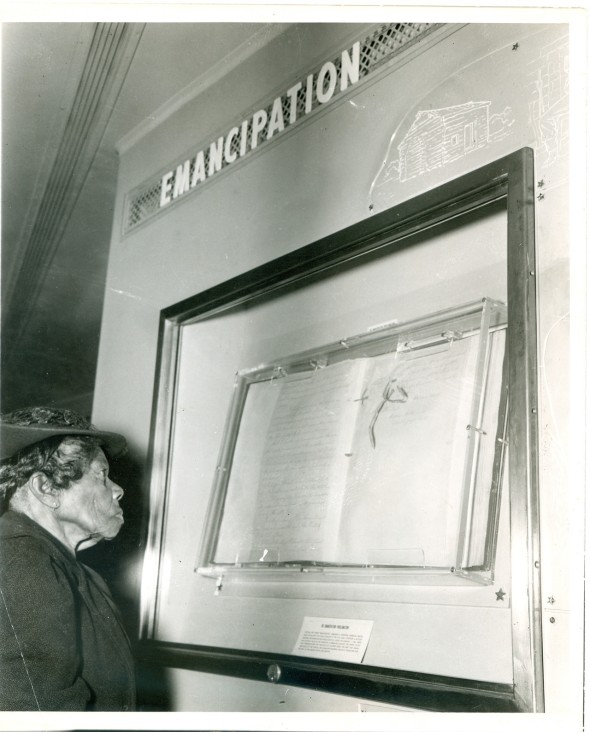A crowd gathers after Jumbo the elephant is struck and killed by a train in St. Thomas, Ontario; September 15th, 1885
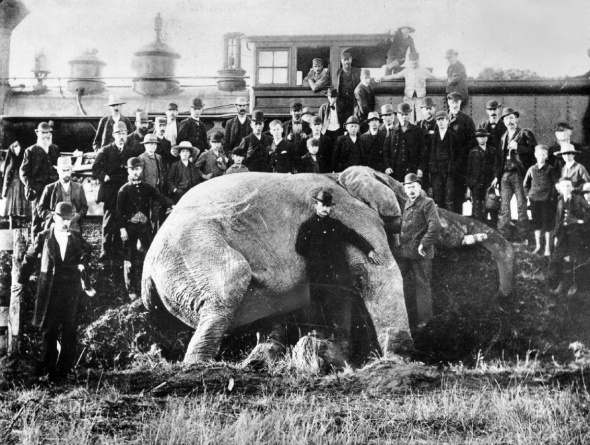
Jumbo was 24 when he was killed on September 15, 1885, in the rail yards at St. Thomas, Ontario, Canada. It was about 9:30 p.m. The circus had just finished a performance. The elephants were being led along the main track in the rail yards to their boxcars. To their left was a steep bank; to their right was the circus train. An unscheduled freight train roared down upon them from the east. The engineer tried to stop the train, but failed. Animal keepers got most of the elephants to safety down the bank. Jumbo and a dwarf elephant called Tom Thumb were the last act on the circus programme and the last to leave the Big Top. Tom Thumb was behind Jumbo. The little elephant was hit by the train and thrown into a ditch. His left leg was broken, but he lived. Jumbo ran down the track away from the oncoming train with Scotty beside him. The locomotive struck Jumbo from behind. He roared in pain as the train carried him 300 feet (91 m) down the track. He was wedged partly above and partly below a flatcar. Jumbo’s skull was fractured in several places. He had serious internal injuries. Blood poured from his mouth and trunk. Jumbo reached for and held Scotty’s hand with his trunk. He died within minutes of the accident. The locomotive and the tender were thrown off the track. They were destroyed in the collision.
A US soldier offers his hand to a woman leaving a cave where she had hidden with her child, Saipan; ca. 1944.
She isn’t only scared by the war, but also by the Japanese propaganda. The Japanese told everyone that Americans would rape and murder them if captured. According to the PBS Nova documentary, the Japanese government told the citizens that in order to become a United States Marine, you had to murder your parents. American loudspeaker units and American marines offered food and safe passage. But many of the civilians were not interested or were too frightened to listen. Some waded into the sea, some used knives, some borrowed grenades from Japanese soldiers… Most though seem to have used a nearby suicide cliff, where whole families walked off into eternity.
*Here’s footage of the suicides from a documentary (showing a actual suicide and some of the bodies at the bottom of the cliffs):
More Information:
According to Wikipeida, 22,000 or the 25,000 civilian inhabitants of Saipan committed suicide at the request of the emperor:
Emperor Hirohito personally found the threat of defection of Japanese civilians disturbing. Much of the community was of low caste, and there was a risk that live civilians would be surprised by generous U.S. treatment. Native Japanese sympathizers would hand the Americans a powerful propaganda weapon to subvert the “fighting spirit” of Japan in radio broadcasts. At the end of June, Hirohito sent out an imperial order encouraging the civilians of Saipan to commit suicide. The order authorized the commander of Saipan to promise civilians who died there an equal spiritual status in the afterlife with those of soldiers perishing in combat. General Hideki Tōjō intercepted the order on 30 June and delayed its sending, but it went out anyway the next day. By the time the Marines advanced on the north tip of the island, from 8–12 July, most of the damage had been done. 1,000 Japanese civilians committed suicide in the last days of the battle to take the offered privileged place in the afterlife, some jumping from “Suicide Cliff” and “Banzai Cliff”.
David Vetter (known as ’The Boy in The Bubble’ in the sterilized plastic environment that was his home from his birth until his death 12 years later); ca. 1978.
David Phillip Vetter (September 21, 1971 – February 22, 1984) suffered from SCID, severe combined immunodeficiency.
‘The chaplain of Texas Children’s Hospital at the time, Rev. Raymond Lawrence, said of the situation: “The great scandal of the Bubble Boy was that he was conceived for the bubble. The team that did this didn’t think through this very well. They didn’t consider what would happen if they didn’t find an immediate cure. They operated on the assumption that you could live to be 80 years old in a bubble, and that would be unfortunate but okay.” Lawrence said that the original three doctors encouraged David’s parents to conceive David so that they could have a test subject for studies, a charge which is denied by the three involved doctors.’
(Source)
An English girl comforts her doll in the rubble of her bomb-damaged home; ca. 1940
These reminders are important for future generations (like us) to not take peace for granted, and to remember that it’s easy to clamor for war if it’s someone else’s house and nation that’s about to get bombed, but when the tables are turned and the bomb whizz over your head, this mechanized mass murder, or whatever watered down PC name war-hungry politicians may give it, is a whole ‘nother beast.
Napoleon’s Exile.
The first abdication was originally conditional. Tsar Alexander had then proposed that Napoleon be exiled to Elba. Even after the unconditional abdication, the marquis de Caulaincourt convinced Alexander to keep the proposition open. Napoleon wasn’t seen as a criminal, an upstart perhaps, but his rule was legitimate and the wars were often declared by the Coalition.
There wasn’t widespread support for Elba, and most diplomats and politicians had their own ideas on where to send him. The United States, Corsica, Sardinia, and the British fort of St. George on Beauly Firth were other possibilities. Alexander insisted on Elba as it would put him at an advantage to Austrian interests, and the other nations went along with it due to the other choices not being entirely pleasing — along with some threats from Alexander that were Napoleon not sent to Elba he would rescind his support for the Bourbons.
When Napoleon escaped, he was declared as much as an enemy of humanity and that he would banished from Europe if captured. He could, in theory, be executed. After Napoleon’s defeat at Waterloo, the Prussians stated that he would be executed if captured by them. For personal reasons, Napoleon refused to surrender to the Austrians and Russians — though they were unlikely to execute him. Napoleon made his way to Rochefort where he planned on embarking to the United States, though he delayed in doing so and the British blockaded the port in the meantime. Napoleon sent his aides to the captain of the HMS Bellerophon to see what terms he might get for surrendering to them. Captain Maitland suggested that asylum in England may be possible, but would have to clear it.
After some deliberation, Napoleon decided to surrender himself to the Bellerophon. When it arrived at Torbay, Napoleon was kept on board — an amusement for sight seers to come and see. The British government debated what to do with him. The three main figures (being the Prince Regent, Prime Minister, and Secretary of War) all hated him and previously instructed the Bourbons that they should execute him. They declared Napoleon a prisoner of war, which put Bonaparte in a grey area of legality. He couldn’t technically be a prisoner of war since Britain and France were no longer at war. Napoleon was no longer considered to even be a citizen of France. The possibility of him being tried and executed as an outlaw or pirate was raised, but then he couldn’t have been detained as a prisoner of war.
The government’s response to this scenario was to exile Napoleon to St. Helena as a retired general on half pay. Napoleon’s response to this was bewilderment and confusion, stating that if his coming aboard the Bellerophon was simply a trick to make him a prisoner, Britain had shamed itself. One of his remarks was, “They may as well call me Archbishop, for I was head of the Church as well as the army.” The Allies approved of the action, though the British Parliament later admitted that the government had no legal basis for Napoleon’s exile.
So, specifically as for why Napoleon wasn’t executed basically comes down to the unique position he was in. The concept of war criminals wasn’t yet around, and Napoleon was neither a figure that could simply be executed nor given asylum. If Napoleon had been given a *writ of habeus corpus, he could have been put on trial. However, the British government didn’t want the possibility for Napoleon to be let off, so they quickly decided to exile him. Even that was outside of their legal jurisdiction, but it caused a lot less fallout than an execution would have.
[*Napoleon technically had received a writ of habeus corpus. A sympathetic former judge came up with an excuse (an admiral failing to perform his duties) to have Napoleon appear as a witness in a trial. The writ was obtained, but Napoleon was whisked away before he could set foot on land.]
American intervention in the Russian Civil War:
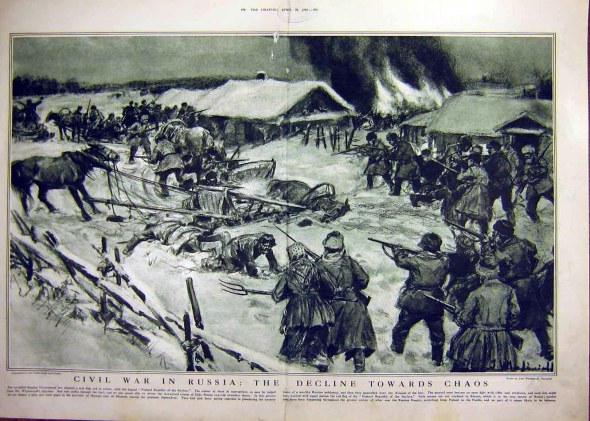 American involvement in Russia was part of an Allied Intervention into Russia rather than an actual invasion. President Wilson authorized limited military force in Russia but no formal declaration of war was ever authorized by the American Congress. Wilson ordered 5,000 men to occupy Arkhangelsk and around 8,000 to Vladivostok, a port city on the far eastern reaches of Russia. The American “expeditionary” forces were not part of a concerted American war effort but rather an American commitment made out of the emerging European debates that followed the First World War. Wilson was also known to use limited occupational forces to achieve political goals. One example is his 1914 occupation of the Mexican port city Veracruz to influence the success of a U.S. friendly Mexican government, obviously Veracruz is a different story but it demonstrates that Wilson used Executive power to authorize military occupations that were not necessarily outright invasions or declarations of war.
American involvement in Russia was part of an Allied Intervention into Russia rather than an actual invasion. President Wilson authorized limited military force in Russia but no formal declaration of war was ever authorized by the American Congress. Wilson ordered 5,000 men to occupy Arkhangelsk and around 8,000 to Vladivostok, a port city on the far eastern reaches of Russia. The American “expeditionary” forces were not part of a concerted American war effort but rather an American commitment made out of the emerging European debates that followed the First World War. Wilson was also known to use limited occupational forces to achieve political goals. One example is his 1914 occupation of the Mexican port city Veracruz to influence the success of a U.S. friendly Mexican government, obviously Veracruz is a different story but it demonstrates that Wilson used Executive power to authorize military occupations that were not necessarily outright invasions or declarations of war.
Importantly the number of around 13,000 thousand American soldiers was considerably less than the commitments of Czechoslovakia’s (50,000), France’s (12,000) and Britain’s (40,000). Moreover the strategic importance of the areas occupied by America were also minor in comparison to other zones of conflict and the role of America was manifestly less significant than the contributions of her Allies. General Graves who commanded the American contingent present in Siberia (American Expeditionary Force Siberia) had the aim of protecting American military equipment and American capital investment that was still in Russia after the abdication of Tsar Nicholas II. Graves’ other objectives included safe guarding the exit of the Czech legion from Russian territory and to assist the reorganization of the new Russian government.
You have to take into account that Russia in 1918 was vastly different from the Communist state that we understand it to have been throughout the twentieth century. In 1918 it was not clear that the Bolsheviks would emerge as victors, the Red Army faced opponents on four fronts to control a comparatively small area compared to the huge country we know Russia is today. The map I’ve linked at the bottom shows the extent of Bolshevik control in 1919, Archangelsk is just at the top, Vladivostok where most of the Americans were stationed is located thousands of kilometers to the east and Americans stationed there engaged in a limited role against Russian Cossacks, a group separate to the Revolutionary Bolsheviks.
Wilson’s motivations for sending American troops were numerous but stemmed from his willingness to see through his own vision for a post war peace process. He was pressured by allies to commit to Russian intervention and he likely did so in a diplomatic measure to ensure he had some leverage in the Paris Peace Conference in 1919. Undoubtedly Wilson was more concerned with fostering a democratic environment in Europe (and protecting physical American interests in Russia) rather than in participating in a huge mobilization against Russia after the toll of the First World War. The intervention was certainly no secret, Congressmen, Newspapers and Citizens were alert to the experiences of American soldiers stationed in the frozen port cities and campaigned for the men to be returned. Generally Americans opposed intervention and largely felt that their commitment in the First World War had been sufficient enough in aiding allied European nations. Additionally many Americans did not share the international spirit that Wilson pushed in the post-war peace conferences. President Warren Harding who followed Wilson’s administration condemned the intervention as a complete mistake.
Here are a couple of good sources if you want to develop some of the ideas that I’ve written here:
(It wasn’t an invasion, it was an intervention authorized by the President and not Congress and the American people knew about it.)
*Maybe the best quick read to get the bet settled that isn’t a wikipedia article.
*The introduction here will help you get a better idea on some of the context surrounding the intervention.
An old woman who fled the war zone with her cow, sits on a bench in Amiens, France; March 28th, 1918
An 18 year old Conchita Cintrón, perhaps the most famous female matador in history, Mexico; ca. 1940
Concepción Cintrón Verrill, also known as Conchita Cintrón or La Diosa de Oro (‘The Golden Goddess’) [1] (August 9, 1922 in Antofagasta – February 17, 2009 in Lisbon), was a Peruvian torera (female bullfighter), perhaps the most famous in the history of bullfighting. In the ring Cintrón was said to display particular grace, style and bravado, a combination known as duende. (From Wikipedia)
Bill Slim and the “Forgotten Army”:
 William Slim was a lower middle class man from Bristol who rose from being a temporary NCO during WWI to getting a commission into the Indian Army during the 20’s to commanding his very own brigade during the early years of WWII until finally arising to becoming a division commander, corps commander and ultimately, army general.
William Slim was a lower middle class man from Bristol who rose from being a temporary NCO during WWI to getting a commission into the Indian Army during the 20’s to commanding his very own brigade during the early years of WWII until finally arising to becoming a division commander, corps commander and ultimately, army general.
In 1942, Bill Slim became commander of the Burcorps in Burma. The Japanese appeared to be unstoppable and soon enough, what had started as defensive campaign turned into the longest retreat in British military history. The British and Indian soldiers in Burma were under-equipped, under-trained, and suffered from serious moral issues. They kept succumbing not only to battle wounds but also tropical diseases and had no way to escape but to walk with their two feet all the way back to India. Imagine being fatigued, not allowed to sleep as you tried to make your way to India as soon as possible before the Japanese could cut your escape route off. Imagine how much you fear to be surrounded by the enemy who seemed to come out of nowhere and infiltrated through your lines. But imagine how much of a difference the spoken word can have. Imagine how you’d feel if you in the middle of all this tropical hell, you were spoken to by a superior in a caring, straight forward and casual way. If you were an Indian soldier, he’d speak to you in your language. Same thing if you were a Gurkha. The British army walked over a 1000 miles back to India only to be received as cowards and as a burden by the British garrison in Assam, India.
Over the next two years, these men as well as completely new divisions and outfits would be trained by Bill Slim in India. They would receive what they didn’t receive in pre-war Burma: Training in jungle warfare. They would learn not to fear the enemy; the enemy was supposed to fear them. if they were being surrounded by the enemy, they were supposed to consider the enemy as being the one surrounded. Never again would there be any frontal attacks, instead it was outflanking through the jungle that was on the schedule. Later training also emphasized co-operation between air support, tanks and infantry. Bill Slim even revolutionized the concept of air drops, using that as a means to supply surrounded units in his tactic of “admin boxes”. The men were given new uniforms, new equipment, new rations and whatever else they needed, yet they were still under supplied. The war in India and Burma was truly forgotten in the home front and the 14th Army, which Bill would establish and build up from scratch, came to be known as “The Forgotten Army”. But this forgotten army was truly a multi-national one. From the ordinary British soldier from the British isles to the Indian soldiers from all over India to the Gurkhas from Nepal and Africans from Nigeria, Sierra Leone, Rhodesia, Kenya, Ghana, Gambia, Uganda, Nyasaland and Tanganyika. All these men would learn to fight, suffer and die next to each other in a campaign that few people cared about. But all of them had one thing in common: They all respected and cared for their general. Bill Slim knew what they had to go through because he often visited the front line and always had a chat with a soldier or two whenever he could. He knew that if he could bring up morale, perhaps the ordinary soldiers could overcome their shortage of everything else. And boy, did they.
Starting with Arakan in 1944, the men under Bill Slim fought and defeated the Japanese. The Japanese had expected an easy victory, expecting the same soldiers they had fought in Burma but this would not be the case. They were met by men who knew their tactics, who could outflank them and who were not afraid of being surrounded by them. Arakan was followed by the battles of Imphal and Kohima in Assam, India which led to the destruction of a large part of the Japanese forces built up in Burma. Operation U-Go, the Japanese invasion of India was stopped in its track and the Japanese were beaten back after ferocious fighting. The 14th Army chased the Japanese to the Chindwin in Burma where they stopped in preparation for the new Burma campaign. Bill Slim would finally get his revenge for the retreat two years ago. In a brilliant battle plan named Operation Extended Capital (which had to be modified from the original Operation Capital due to the changes in circumstances), he used surprise, ruse, timing and maneuver into something which became his masterpiece. One of his corps was to take Meiktila, crossing the Irrawady in the south while the other corps would cross the Irrawady in front of Mandalay to make it seem like they were the main attack. By taking Meiktila, the 14th Army would be on the flank of the Japanese and this would mean the end of operations there. This plan succeeded beyond belief and after that, the road to Rangoon was practically open.
Bill Slim was in many ways the most down to earth general in WWII. He knew and understood the ordinary soldier because he knew where most of them came from. He had personally spent time amongst workers and miners in Bristol as well as worked in a poverty stricken school where he first got his insight into a different world. He never made himself out as being anything but Bill Slim, treating everyone with kindness, humor and patience. He rarely got angry and he was incredibly self-deprecating, blaming all mistakes on him and him alone. Not even in his post-war memoir did he choose to say anything bad about anyone, even those who hated him. He loathed publicity and remained as modest as he could be. He was beloved by his men and never cared about gaining glory or recognition. Despite this, Bill Slim was given the title of Field Marshal, was knighted several times, received the title of “Viscount Slim” as well as the Distinguished Service Order. But in the very end, it wasn’t the titles, the knighthoods or the medals which became his most important title. In the very end, it was the affectionate nickname of “Uncle Bill” given to him by his men which held the most truth to it.
Personally, there is something in this story which not only is inspirational but also seems like a life lesson. Bill Slim was a modest, simple man who found himself in an extraordinary situation after the other. But he never gave up and realized that if you go that extra mile, the people who look up to you will as well. There is also an element of unfairness in this as well, seeing as how the 14th Army sacrificed so much only to live forever in the shadow of all the other theatres of war in WWII. The fact that the 14th Army didn’t even receive a proper welcome home or a parade is inexcusable, according to me.
Marching Belgian Carabiniers leading their dog-drawn machine gun carts towards the front line during the German invasion of Belgium; ca. 1914
“Marching toward the camera, and shot from a low angle, these Belgian Carabiniers are given a powerful sense of purpose by the photographer. Clean uniforms and neat formation say the soldiers have not come from battle.
These are the early days of WWI and Belgium has been invaded by the Germans in a surprise move. The Germans, 600,000 strong, were confident against the small Belgian Army of around 117,000, who were ill-equipped and poorly trained.
Yet the Belgians fought bravely in and around their fortifications in the Liège area. They held up the German advance for ten days before withdrawing on 16 August, when the Liège system finally fell. This delay would prove crucial to the French forces’ ability to re-organise and oppose the German push through Belgium into France.
King Albert I had ordered his Army to retreat to the ‘National Redoubt’ at Antwerp, consisting of over 40 forts and several lines of defence. Our Carabiniers are part of the force sent forward to cover that retreat by confronting the advancing Germans.
Marching out of the foggy background, the Carabiniers, with their Tyrolean hats and dog-drawn heavy machine-gun, look as if they are striding out of the past into the light of 20th century warfare. Almost like gentlemen in top hats taking their dogs for a walk.
The traditional dress of the Carabiniers, a light-infantry unit, was a tunic and greatcoat of a green so dark that the German nickname for them was the ‘black devils’. Many new recruits, however, were given a greatcoat of the more usual Belgian Army dark blue because of the chaotic supply situation. Despite their old-fashioned uniforms, their machine-guns were effective enough, though both soldier and dog were to pay a high price.
Although the main German forces bypassed Antwerp, four divisions had to be diverted to contain the Belgian forces there, further weakening the thrust into France. Antwerp did not fall until 9 October.”
“Abandoned baby sleeping in desk drawer at Los Angeles Police station”, 197.
IMPROVISED CRIB–Policewoman Pat Johnson, 28, tends a baby girl, about 9 months old, who was found alone and crying in a downtown hotel room. Baby was placed in file drawer for a nap after she was fed milk, Jell-O and cottage cheese. She later was taken to a foster home. The hotel manager called police after receiving complaints that the baby had been crying for hours.
Laika (c. 1954 – November 3, 1957) was a Soviet space dog who became one of the first animals in space, and the first animal to orbit the Earth.
Laika was a stray dog, originally named Kudryavka (Russian: Кудрявка Little Curly); she underwent training with two other dogs, and was eventually chosen as the occupant of the Soviet spacecraft Sputnik 2 that was launched into outer space on November 3, 1957, (becoming the first dog in space, to orbit the Earth, and was also the first animal to die in space.) The Soviets designed the spacecraft knowing she would not survive. One Soviet scientist took her home to play with his children because he said “I wanted to do something nice for her. She had so little time left to live.” Laika likely died within hours after launch from overheating, possibly caused by a failure of the central R-7 sustainer to separate from the payload. The true cause and time of her death was not made public until 2002; instead, it was widely reported that she died when her oxygen ran out on day six, or as Soviet government initially claimed, she was euthanized prior to oxygen depletion.
As a kid who was very into rockets and airplanes I remember being told about her (mind you, I wasn’t born until the cold war was ending), but in my childish innocence I assumed she came back okay.
Here’s a statement made by Oleg Gazenko, one of the Sputnik scientists:
“Work with animals is a source of suffering to all of us. We treat them like babies who cannot speak. The more time passes, the more I’m sorry about it. We shouldn’t have done it… We did not learn enough from this mission to justify the death of the dog.”
You know what makes me (sorta) happy? They built her a window. Despite the challenges and costs of building a secure window in a pressurized capsule, they did it so the dying dog could look out.
Source here:
Gazenko speaks of the bond that grew between the dog and him as they worked toward her mission, leading us in unembroidered prose through a brief tale of preparation, hours of readiness on the launch pad, and the launch itself. But the heart of the article for me, and the part to which nothing I’ve found since makes reference, is this: Gazenko tells us that as engineers rushed against deadlines to complete the capsule that would carry the dog into space, outfitting it with equipment to record the details of her death, he took on a battle in Laika’s behalf. Against heavy objections from the decision-makers, he insisted upon the installation of a window. A window in a space capsule, where such a luxury would cause complications and expenses that I can barely imagine. A window for the dog whose monitored demise had been this man’s objective in all the interactions that had bonded her to him with the eager devotion of every well-trained working canine.
Yet Gazenko persisted and prevailed.
Roof In Peace.
Pacific Southwest Airlines Flight 182 Going Down over San Diego after Colliding with Another Plane, 1978.

Reading the transcript of this, the last thing said was “Ma, I love ya” by an unknown person (probably the captain). That almost brought me to tears.
144 dead including 2 in the Cessna, 7 on the ground (2 children). With a reported impact speed of 300 mph, the Boeing 727 crashed into the North Park residential neighborhood of San Diego, CA.
Kind of a heartbreaking photo, knowing the outcome and reading the radio transcripts.
Photos of the plane in the air were taken by photographer Hans Wendt who was attending a press event. (A local news cameraman captured the fall of the Cessna on film, but I could not locate the footage.)
*Not only did no one survive, nobody made it intact.
“The accident was notable for the carnage it created. Only a few of the bodies were found recognizable and intact. First responders on the scene found pieces of bodies scattered throughout the area, including on rooftops and against trees, and gore splattered on walls.” (Source)
88-year-old Mrs. Sally Fickland, a former slave, looking at the Emancipation Proclamation in 1947.
Due to its fragile condition—it was printed on both sides of poor-quality 19th-century paper, unlike the Constitution, which is written on more durable parchment—the Emancipation Proclamation can only be displayed for 30 hours each year.
Did celebrity efforts like Band Aid’s “Do they know it’s Christmas?” and USA for Africa’s “We Are The World” actually help alleviate famine in the 1980s?
Some people will say that the musicians selflessly raised large amounts of money to help the world’s neediest. Others – myself included – would say that when projects like this don’t involve professional humanitarianism and the beneficiaries (i.e. the people who are supposedly being helped), the law of unintended consequences allows for the best of intentions to pave a road straight to H-E-double-hockeysticks.
There’s three broad ways that Celebrity Aid is often asserted as a success, or conversely, criticized as a failure. Namely they are (1) the amount of aid that actually hit the ground, (2) the stereotypes of Africans it created in the media, and (3) that they may have actually been complicity in ethnocide in the Sub-Saharan African context. I’ll address each separately.
(1) The amount of aid that hit the ground.
Band Aid famously started when Bob Geldof led the charge to raise money for famine in Ethiopia. Naturally, it was done with the best of intentions. The problem is that whereas most people think of famines as natural disasters they are in fact socio-political disasters. To put it another way, there are two models of famine, “food availability decline” and “food entitlement decline” (this is most famously discussed by Amartya Sen). In most cases of famine – for example Ethiopia in the 1980s – there was plenty of food available – the problem is that the poorest people didn’t have access to it, i.e. they weren’t “entitled” in the sense that they couldn’t afford it. When crops fail, there is usually still enough food around to feed people, however the reduced amount of food creates inflation, thus driving up prices. Dumping more money into a hurting economy doesn’t help this (see Dambisa Moyo or Paul Collier’s discussion of aid and Dutch Disease), it worsens things by putting more money in the hands of the wealthy. Additionally, don’t forget that a huge amount of the money raised goes to covering costs of holding these events (honorariums for the artists are a part of this). Much is further siphoned off on the way (including by governments, I’ll get to that in part 3). This is assuming that the aid that arrives is delivered professionally. Humanitarian actors have learned in the last two decades that projects not directly involving local beneficiaries are doomed to failure, and this is still rarely put into practice. Therefore, though millions of dollars are raised, much of it doesn’t hit the ground, and what does hit the ground is more likely to cause further damage and upset the local economy, than to actually save lives.
(2) Media portrayals of Africa
By showing lots of images of starving children with flies on their faces, the image of Africa becomes one of suffering and backwardness, rather than being a continent of diversity of life, culture, religion and experience that rivals that of any other. This video of a tract by Binyavanga Wainana (read by Amistad’s Djimoun Hounsou) describes this issue much better than I can. Basically, the image of Africa as the ‘dark continent’ full of savage warriors and starving babies is not an accurate depiction, and events like Band-Aid and We are the World perpetuate these not only false but outright racist depictions of life in the developing world. The interaction that most people have with “Africa” as a concept therefore becomes the starving child with the flies on its face, rather than learning of the history of the Mali Empire, the Songhai Great Zimbabwe, Shaka Zulu, or of learning the literature of Chinua Achebe or Wole Soyinka, or even learning the inspiration recent struggles of anyone from Nelson Mandela or Zackie Achmat amongst countless others. Instead, when you ask people what happens in Africa, you get the image of the starving child. Band Aid played a more central role than anything else in constructing this image.
(3) Complicity in mass murder and ethnocide
This is the most controversial aspect of Band Aid and related endeavours that there are. Many (including Tim Allen, Alex de Waal) have argued that Band Aid was directly complicit in the mass murder of hundreds of thousands of people. This is a highly contentious point. A brief history lesson: Ethiopia was ruled by the West’s darling Haile Sellasse, before he was ov3ertrhown by a nominally-Marxist ruler called Mengistu Haile Mariam. His party, known as the Derg, received support from the USSR. In the early 1980s, a group of Ethiopian ethnic minorities rose up against his rule (a larger one was the Oromo Liberation Front, although Eritrean groups were very active). When crops began to fail (this occurred cyclically, with the worst year being 1984), Mengistu blocked aid to the region, blocked refugees from leaving, as while limiting the international assistance that arrived. What assistance did arrive was taken by the regime, and not sent to the minority areas. Though the regime definitely didn’t cause the famine, they undoubtedly made it worse, using it as a cheap form of counterinsurgency (similar uses of famine as a form of counterinsurgency occurred in the Biafran War in Nigeria in the 1970s, and in Darfur in the 2000s). Support for “Ethiopia” became support for the Derg, and the famine it perpetuated in minority areas of Gojjam, Eritrea, Hararghe, Tigray, and Wollo. Basically, in their attempts to raise money for starving children, fundraising ended up providing legitimacy to the Ethiopian regime, while also sending it lots of money that was inevitably re-directed to other areas (especially corrupt politician’s pockets).Along with Operation Lifeline Sudan, and assistance in the Biafran War, the Live Aid / Band Aid exploits are held up as the three most famous examples of humanitarianism gone wrong, and the best of intentions being manipulated by local actors to pursue policies of ethnocide.
The idea that we must “do something” and that we must “save the world” is dangerous if you don’t deliver aid professionally, through professionalized humanitarian channels no embodied in organizations like MSF, Oxfam, etc., with the involvement of the beneficiaries on the ground. The rather embarrassing Band Aid saga speaks to this point as well as anything else. Good intentions and cash simply aren’t enough; we need to do better.
How much did Band Aid/ We are the World/Live aid help? The optimistic answer would be “not much”, while the cynical answer would be “it actually made things worse”. But the silver lining would be that it helped professional humanitarians (i.e. not musicians, but actual trained NGO staff) sharpen their game and improve their delivery, to avoid the disasters that come when you deliver aid in an unprofessional manner.


